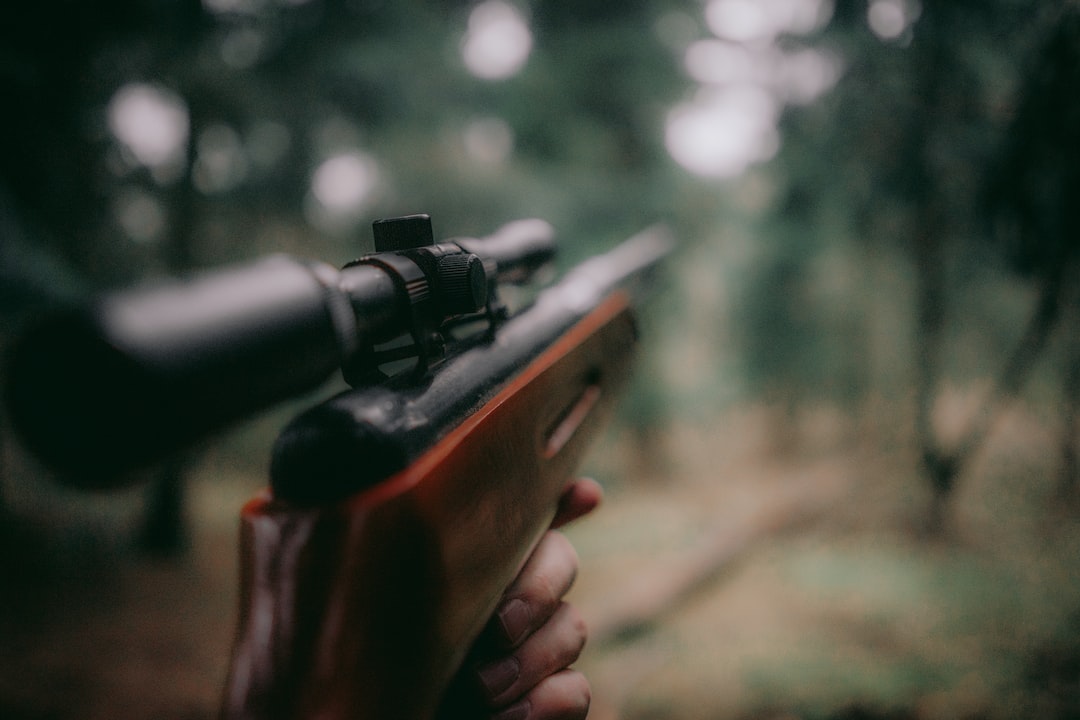Sighting in a rifle can be the difference between bagging that trophy buck or coming home empty-handed.
Whether it’s for varmint hunting, target shooting, or big game hunts, understanding how to sight in a rifle is an essential skill for any outdoorsman.
But what factors should you consider when sighting in your firearm and what steps are involved? How do ballistic drop charts work and why is accuracy so important when aiming down range?
We’ll answer all these questions and more as we explore everything from choosing the right gun to mounting scopes correctly – even setting up a shooting bench.
So get ready to become an expert marksman with our comprehensive guide on “sighting in” your rifle.
Here’s a video that breaks down the rifle sight in process:
Choosing the Right Rifle
When selecting a rifle for hunting, there are several factors to consider. The type of rifle, caliber selection, and barrel length and twist rate all play an important role in determining the accuracy of your shots.
Types of Rifles:
There are two main types of rifles used for hunting; bolt-action and semi-automatic.
Bolt-action rifles have a single shot capacity with each pull of the trigger while semi-automatic rifles can fire multiple rounds with one pull. Both types offer different advantages depending on what you plan to use it for.
For example, if you’re looking for more accuracy when shooting at longer distances then a bolt action would be better suited as they tend to be more accurate than their semi-automatic counterparts due to less moving parts inside the gun that could affect precision.
Caliber Selection:
Choosing the right caliber is also important when selecting a rifle for hunting purposes. We are talking about the size of the rifle barrel and bullet diameter here. Calibers range from .22 LR up to .50 BMG (Browning Machine Gun).
Generally speaking, larger calibers will provide more power but may not always be necessary depending on what game you’re targeting or how far away it is from you when taking aim.
Smaller calibers such as .270 or .308 Winchester are great choices if you’re looking for something that packs enough punch without being too powerful where recoil becomes an issue during follow up shots or long distance shooting sessions.
You can even mess with bullet weight / bullet grain, the amount of powder used to develop your own hunting round that your rifle shoots well with. If you don’t have the time and resources to re-load, find a readily available factory load that your rifle shoots well with and stock up on it before they go out of stock.
After selecting the right rifle for your needs, it’s time to mount and properly sight in the scope. With proper torqueing of the rings and bases, leveling of the reticle and turrets, and setting eye relief distance correctly, you can ensure that your rifle is ready to perform when needed.
Mounting the Scope
Properly mounting a scope is essential for accurate shooting. It’s important to take the time to ensure that your scope is mounted correctly, as this will help you achieve better accuracy when sighting in your rifle.
Starting with properly torqueing the rings and bases, it’s recommended to use a torque wrench set at 20 inch-pounds or less.
This will help prevent over tightening and potential damage to the scope tube or base screws. Make sure that all screws are tightened evenly so that there is no distortion of the mount itself.
Leveling the reticle and turrets should be done next. To do this, place a bubble level on top of the turret housing while keeping an eye on how much adjustment needs to be made between each screw turn until both levels are evened out horizontally and vertically. This helps keep track of any adjustments needed when sighting in later on down the road.
Lastly, setting eye relief distance ensures that your eye remains far enough away from recoil during firing without sacrificing visibility through your scope lens.
The optimal distance varies depending on caliber size but generally ranges from 3-4 inches for most standard riflescopes; however, some may require more or less depending on personal preference or rifle type used (e.g., muzzleloader). Experimentation can help find what works best for you.
Once you have your scope mounted, it’s time to begin the sight-in process and get your rifle zeroed in for a successful hunt.
Sight-In Process
Establishing a zero range involves firing test shots at a target from a predetermined distance and adjusting for windage and elevation until you have achieved the desired accuracy.
Firing test shots helps you to identify any inconsistencies with your rifle’s trajectory, allowing you to make adjustments accordingly.
When aiming, be sure to take into account factors such as wind speed, humidity, temperature, and altitude which can all affect the bullet’s flight path. Once you have fired enough rounds that are consistently hitting the target where intended, it is time to confirm your zero range.
You want your shooting groups to be within an inch or two of each other at 100 yards. Remember, If you are off by 3 inches at 100 yards, you will be off by more than a foot at 400 yards. Precision is crucial to form a tight shot group.
This means shooting at least three more rounds from the same distance without making any further adjustments or corrections; if these three rounds hit within 1 inch of each other then your zero range has been confirmed. That’s a tight shot group at 100 yards and should translate to accuracy as you move out to longer ranges.
Shooting over and over again can cause your barrel of your gun to heat up. This is normal, but pay attention to your barrel heat and take rests in between shots to prevent it from getting too hot. Barrels can warp if they get too hot which will throw off the accuracy of the rifle.
Once you have established and confirmed your zero range, it is time to calculate MOA or MILs for drop charts in order to comprehend the trajectory of bullets when fired at different distances beyond what was used for sight-in purposes.
MOA stands for Minute Of Angle while MIL stands for Milliradian; both are units of measurement utilized by shooters when calculating ballistic drop charts based on their specific ammunition type and muzzle velocity (MV).
By understanding how much drop there will be between various distances, this allows shooters to adjust their aim point accurately before taking a shot instead of relying only on guesswork or trial-and-error methods which could result in missed targets or wasted ammunition due to incorrect calculations made beforehand.
Learn about how to sight in a bow here.
Now that you understand the sight-in process, it’s time to move on to understanding ballistic drop charts and how shooting from a bench or prone position can help improve your accuracy.
Ballistic Drop Charts
Calculating MOA or MILs is essential for determining your ballistic drop chart. Knowing this information can help you adjust for windage and elevation more accurately when sighting in your rifle.
MOA stands for Minute of Angle, which is an angular measurement that corresponds to 1/60th of a degree. It’s used to measure the accuracy of a firearm at different distances. MIL stands for Milliradian, which is another angular measurement equivalent to 0.05 degrees or 3 minutes of angle (MOA).
Determining Your Drop Chart involves plotting out the bullet trajectory over various distances based on the data from your calculations with either MOA or MILs measurements. This will give you an idea as to how much adjustment needs to be made in order to hit a target at any given distance away from you while shooting with a rifle scope attached onto it.
The drop chart also helps shooters understand their bullet trajectory better so they can make more accurate adjustments when aiming their rifles at targets further away than what they are accustomed too
Understanding Your Bullet Trajectory requires knowledge about gravity and air resistance, two forces that affect bullets as they travel through the air after being fired from a gun barrel towards its intended target destination point.
By understanding these two forces, shooters can make better estimations regarding where their bullets will land relative to their original aiming point before firing them off. For example, if there’s wind present then adjusting for it accordingly by adding extra holdover could mean hitting closer shots even though the shooter might have been slightly off initially due his estimation error.
Shooting from a bench or prone position offers benefits depending on the individual situation and preference of the shooter. Shooting from a bench provides stability since most benches come equipped with rests, allowing shooters to rest both arms comfortably while taking aim.
On the other hand, shooting prone gives one greater mobility since they have less equipment strapped onto them, making it easier to maneuver around obstacles such as trees and rocks without anything getting in their way during their shot execution process.
FAQs in Relation to How to Sight in a Rifle
Do you chase the bullet when sighting in a scope?
No, you should not chase the bullet when sighting in a scope like you would with a bow. If your shot is left, adjust the windage of your scope to the right. If your shot is low, adjust the elevation on your scope up.
It is important to take your time and adjust the scope for accuracy. Start by adjusting the windage and elevation knobs until the crosshairs are centered on the target.
Once this is done, fire a few shots at a known distance to ensure that your adjustments were correct. If they are off, make small adjustments to get them back on target before firing more rounds. Taking your time with this process will help ensure that you have an accurate zero for hunting success.
Where do you sight-in a hunting rifle?
Sighting-in a hunting rifle is an important step in ensuring accuracy and safety while out in the field. The best place to sight-in your rifle is at a shooting range that has a bench rest or sandbags for stability.
Make sure you have enough distance between you and the target, typically 100 yards or more, so that you can accurately adjust your sights. Ensure that there are no obstructions between you and the target such as trees or buildings.
It’s also important to use quality ammunition when sighting-in your rifle, as this will help ensure accuracy and consistency with each shot. You need to use the same brand, grain, and style as you are going to use to hunt with so that your scope is dialed into your hunting round.
With patience and practice, sighting-in your hunting rifle should be relatively straightforward.
Is it hard to sight a rifle?
Sighting a rifle can be challenging, but it doesn’t have to be. It requires knowledge of the basics and practice with your firearm. The process involves aligning the sights on the gun so that when you fire, your bullet will hit where you aim.
Pay attention to your barrel heat. If it starts feeling super hot to the touch, set your rifle in a shaded area to cool off for a few minutes before shooting again.
You’ll need to adjust for windage and elevation, as well as any other environmental factors that may affect accuracy. With patience and practice, sighting a rifle can become second nature – allowing you to take accurate shots in any situation.
How often should you sight-in a rifle?
It is recommended that you sight-in your rifle at least once a year, or more often if you use it frequently. This will ensure accuracy and consistency when shooting, as environmental factors such as temperature, humidity, and elevation can affect the trajectory of your bullet.
Additionally, checking for any signs of wear or damage to the scope should be done regularly in order to maintain optimal performance. Taking time to properly sight-in your rifle will help ensure successful hunts and help you bring home that elk or deer to mount in the living room.
Conclusion
When it comes to sighting in a rifle, the most important thing is to take your time and do it right. It’s not something you want to rush through.
By taking into account factors such as mounting the scope properly, understanding how MOA works, and learning about ballistic drop charts, you can ensure that your rifle is sighted in accurately for whatever type of shooting you plan on doing.
With proper preparation and knowledge of what goes into sighting in a rifle, you’ll be able to enjoy successful hunting trips with confidence knowing that your gun is ready for action.



